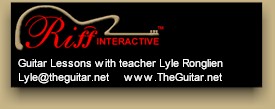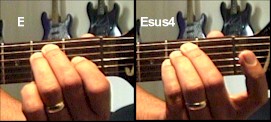Scroll through the lesson and click on notation/video/audio links to load the interactive players.
Please subscribe to get full access to all lessons for only $7.95/month PLUS 1 week free trial.

Riff Interactive lessons are
LESS expensive and
MORE interactive than alternatives!
More Info
|
|

Jam Sessions - Rock
Style II
Lesson 6 - E Major
Lyle:
This jam track is in the key of E major. It has a "rock power ballad" sound to
it. Here's the chord chart and jam track:
chord
chart

Lyle:
The jam is made from two simple chords played in the open position:
chords

Lyle: That's just the chords, here's the strum
pattern for the rhythm riff:
Lyle:
You can use an acoustic guitar for the rhythm riff or an electric guitar set for
a fairly clean setting, and try the neck or middle pickup. Add chorus and a
little reverb to spice it up!
Lyle: You can select the loop feature for the tab
playback on this or any of the riffs if that helps you learn it.
Lyle: Now you know how to play the rhythm guitar part for this jam, next I'll show you
a few ideas of things you can learn to play against the jam track. Here is the
first riff from the lesson sample. It's made mostly from this pattern for the E
major pentatonic scale:
Lyle:
How we doing out there?
TomH: I'm jamming on the Emaj pent
now.
Ken:
bending, lots of bending.
jerry: Doin' ok
Lyle.
Lyle:
Good.
Lyle: Since you are working in the key of E
major, you can play any mode from the key of E.
Lyle: The next riff uses the 2nd mode in the key
of E, the F# Dorian minor mode:
Lyle:
You could use octaves with the 5th and 3rd strings to produce a thick melodic
sound like the next riff example made from notes in the E major pentatonic:
Lyle:
Now you've learned 3 different things to use when jamming along to this jam
track. The first thing was the E major pentatonic scale, second was the F#
Dorian minor mode, and the third thing was sliding around notes in the E major
key using octaves.
Ken: Do you mute the 4th string in this
riff?
Lyle:
Yes.
Picky: If
you're on the spot for a solo just jamming with your friends, how would you know
which scale to use?
Lyle: You have to know what chords are being used
while you're jamming, that way you can figure out what key you might be in and
then choose the scale you want to use.
Lyle: "Learn your scales"!
Picky:
So now that you know what scale to use, how do you make said scale sound like
music and not a scale?
Lyle: Good question. From time to time I show you
musical ways to play a scale in almost every lesson. I have a great example
coming up.
TomH: Don't play them in the exact order, mix them
up
Lyle:
That's a good idea.
TomH: Nobody but other musicians will know what you are
doing anyway :)
Lyle: Arpeggios are every other note in a scale
for the most part. Arpeggios are the notes that make up a chord. They are also
fun to learn and play in any musical situation.
Lyle: If
we took the 7 tones of the E major scale and learned each of the resulting modes
and chords that come from the harmonized E major scale, you would end up with
these 7 chords all directly related to the key of E:
Lyle:
Emaj7 - F#m7 - G#m7 - Amaj7 - B7 - C#m7 - D#m7b5
Lyle:
Here's one way to play these arpeggios up the neck starting with E maj:
Lyle:
Remember you can slow the tab down and loop it if that helps you learn and
practice it.
Lyle: The next riff is a 'musical' way of playing
a scale. I'm simply playing unison bends ascending up two octaves of the E major
scale:
Lyle:
See how a scale can sound musical? It's all how you play it.
Lyle:
The last riff in the lesson sample is all made from natural harmonics. Strike
the note while the fret-hand lightly touches the string directly over the fret
indicated.
Lyle:
Here's how the last riff of the lesson sample was played. Each note is a natural
harmonic:
jerry: Lyle,
what do you use for your sustain?
Lyle: My fingers.
Lyle: I don't let the strings fret
out.
Lyle: Add a little vibrato too. That helps keep
the strings vibrating/sustaining.
Lyle: Ok, that's it for this lesson. Hope you
have fun jammin'! All the jam tracks from this series are available
for download in high quality MP3 format. Visit my web site TheGuitar.net
and go to Jam tracks for more info. Thanks - Lyle
|
<< load notation from left
|
|
<< load audio from left
|
<< load audio from left
|